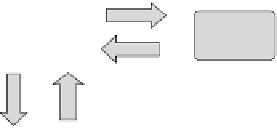Geoscience Reference
In-Depth Information
the first place to predict their elastic properties [CHA 88, CHA 89, EME 96, LIA 00,
WAL 87]. More recently, the same techniques have been applied with more or less
success for modeling non reversible behavior [JEN 93, NEM 02]. The basic idea for
most of these models is to consider the granular medium as a collection of tangent
planes at the contact points between grains interacting with each other. This
approach requires us to write the contact law along these tangent planes and develop
homogenization operators in order to integrate all these contacts at the scale of the
representative elementary volume.
Two techniques have been considered (see Figure 7.1). The kinematic approach
is based on a localization operator, which provides a relationship between
intergranular contact displacements and the assembly strain, and a homogenization
operator, which relates the average stress of the granular assembly to a mean field of
particle contact forces (see, for example, [NIC 05]). The static approach is based on
an inverse technique consisting of a localization operator relating the macro stresses
to the local contact forces and a homogenization operator relating the grain
displacements to the macro strains. Both approaches relate local forces and
displacements through a constitutive law at the contact level. The micro-structural
model presented in this chapter is based on a static approach presented in the
following section [CHA 05], which appears to be more suitable for describing the
behavior of granular materials. The kinematically constrained models are more
popularly used in concrete models. The overriding reason for using this approach is
that, in the case of strain softening, it is easier to construct a stable model using a
kinematic rather than a static constraint. However, the kinematic constraint
obviously gives a more restrictive deformation pattern and thus provides a stiffer
result, especially when granular materials are subjected to high deviatoric stresses
[CHA 90].
α
Δ
ε
ij
C
σ
=
Δ
ijkl
kl
Stress-strain Law
Macro Level
Stress
Strain
Inter-particle
force
Inter-particle
movement
Micro Level
Inter-particle law
α
α
α
δ
Δ=Δ
K
ij
Figure 7.1.
Homogenization techniques for granular materials






Search WWH ::

Custom Search